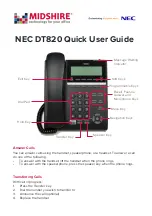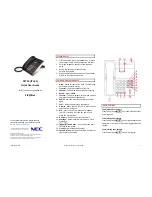
Theory of Operation
△
GSM System Description
General Cellular Concept
The cellular systems are used to provide radiotelephone service in
the frequency range 890-960 MHz. A cellular system provides higher
call handling capacity and system availability than would be possible
with conventional radiotelephone systems (those which require total
system area coverage on every operating channel) by dividing the
system coverage area into several adjoining sub-areas or cells.
Each cell contains a base station (cell site) which provides
transmitting and receiving facilities, for an allocated set of duplex
frequency pairs (channels). Since each cell is a relatively small area,
both the cell site and the radiotelephone that it supports can operate at
lower power levels than would be used in conventional systems.
Using this technique, radiation on a given channel is virtually
contained in the cell operating on that channel and, to some extent,
those cells directly adjacent to that cell.
Since the coverage area of a cell on a given channel is limited to a
small area (relative to the total system coverage area), a channel may
be reused in another cell outside the coverage area of the first. By this
means, several subscribers may operate within the same geographic
area, without interference with each other, on a single channel.
GSM Description
Unlike previous cellular systems, GSM uses digital radio
techniques. The GSM system has the following advantages over
previous analogue systems:
♦
International Roaming
-
Due to international harmonization and
standardization, it will be possible to make and receive calls in any
country, which supports a GSM system.
6
Содержание C200
Страница 2: ......
Страница 4: ...4 May 19 2003 6809464A58 Contents Product Family D10 ...
Страница 18: ...18 May 19 2003 6809464A5 O General Operation Product Family D10 PRELIMINARY ...
Страница 41: ......
Страница 78: ...BenQ Rev 1 0 37 ...
Страница 79: ...BenQ Rev 1 0 38 ...
Страница 80: ...BenQ Rev 1 0 39 ...
Страница 81: ...BenQ Rev 1 0 40 ...
Страница 82: ...BenQ Rev 1 0 41 ...
Страница 83: ...BenQ Rev 1 0 42 ...
Страница 84: ...BenQ Rev 1 0 43 ...
Страница 85: ...BenQ Rev 1 0 44 ...
Страница 86: ...BenQ Rev 1 0 45 ...
Страница 87: ...BenQ Rev 1 0 46 ...
Страница 88: ...BenQ Rev 1 0 47 ...
Страница 89: ...BenQ Rev 1 0 48 ...
Страница 90: ...BenQ Rev 1 0 49 ...
Страница 91: ...BenQ Rev 1 0 Radio Frequency function Descriptions Top Side 50 Bottom Side ...
Страница 92: ...BenQ Rev 1 0 51 ...
Страница 95: ...BenQ Rev 1 0 54 Apollo Block Diagram ...
Страница 96: ...BenQ Rev 1 0 Tx Block Diagram 55 ...
Страница 97: ...BenQ Rev 1 0 56 Rx Block Diagram ...
Страница 98: ...BenQ Rev 1 0 57 TX Front End EGSM DCS ...
Страница 99: ...BenQ Rev 1 0 58 Rx Front End EGSM DCS ...
Страница 100: ...BenQ Rev 1 0 59 RF power management ...
Страница 101: ...BenQ Rev 1 0 60 Tx Power ...
Страница 102: ...BenQ Rev 1 0 VCXO 61 ...
Страница 103: ...BenQ Rev 1 0 Base Band full schematic 62 ...
Страница 104: ...BenQ Rev 1 0 RF full schematic 63 ...
Страница 140: ...BenQ Rev 1 0 Replacement Parts Exploded View 99 Fig 1 Mechanical Exploded View I ...
Страница 141: ...BenQ Rev 1 0 Fig 2 Mechanical Exploded View II 100 ...
Страница 142: ...BenQ Rev 1 0 Fig 3 Mechanical Exploded View III 101 ...
















































